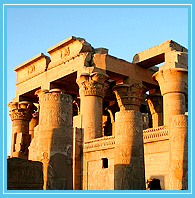|
|
| |
| |
 |
| |
|
| |
The occupation of Egypt by the forces of Alexander the Great in 332 BC brought an end to Persian rule. Alexander appointed Cleomenes of Naucratis, a Greek resident in Egypt, and his Macedonian general, known later as Ptolemy I, to govern the country. Although two Egyptian governors were named as well, power was clearly in the hands of Ptolemy, who in a few years took absolute control of the country.
|
|
| |
|
|
| |
|
| |
Rivalries with other generals, who carved out sections of Alexander's empire after his death in 323 BC, occupied much of Ptolemy's time, but in 305 BC he assumed the royal title and founded the dynasty that bears his name (see Ptolemaic Dynasty). Ptolemaic Egypt was one of the great powers of the Hellenistic world, and at various times it extended its rule over parts of Syria, Asia Minor, Cyprus, Libya, Phoenicia, and other lands. |
 |
|
| |
|
|
| |
Partly because native Egyptian rulers had a reduced role in affairs of state during the Ptolemaic regime, they periodically demonstrated their dissatisfaction by open revolts, all of which were, however, quickly suppressed. In the reign of Ptolemy VI, Egypt became a protectorate under Antiochus IV of Syria, who successfully invaded the country in 169 BC. The Romans, however, forced Antiochus to give up the country, which was then divided between Ptolemy VI and his younger brother, Ptolemy VIII; the latter took full control upon the death of his brother in 145 BC. |
|
| |
|
|
| |
The succeeding Ptolemies preserved the wealth and status of Egypt while continually losing territory to the Romans. Cleopatra VII was the last great ruler of the Ptolemaic line. In an attempt to maintain Egyptian power she aligned herself with Julius Caesar and, later, Mark Antony, but these moves only postponed the end. After her forces were defeated by Roman legions under Octavian (later Emperor Augustus), Cleopatra committed suicide in 30 BC. |
|
| |
|
|
| |
|
| |
For nearly seven centuries after the death of Cleopatra, the Romans controlled Egypt (except for a short time in the 3rd century AD, when it came under the power of Queen Zenobia of Palmyra). They treated Egypt as a valuable source of wealth and profit and were dependent on its supply of grain to feed their multitudes. Roman Egypt was governed by a prefect, whose duties as commander of the army and official judge were similar to those of the Pharaohs of the past. The office, therefore, was one with which the native population was familiar. Because of the immense power of the prefects, however, their functions were eventually divided under Emperor Justinian, who in the 6th century AD put the army under a separate commander, directly responsible to him. |
 |
|
| |
|
|
|
| |
Egypt in the Roman period was relatively peaceful; its southern boundary at Aswan was only rarely attacked by the Ethiopians. Egypt's population had become Hellenized under the Ptolemies, and it included large minorities of Greeks and Jews, as well as other peoples from Asia Minor. The mixture of the cultures did not lead to a homogeneous society, and civil strife was frequent. In 212, however, Emperor Caracalla granted the entire population citizenship in the Roman Empire. |
|
| |
|
|
| |
Alexandria, the port city on the Mediterranean founded by Alexander the Great, remained the capital as it had been under the Ptolemies. One of the great metropolises of the Roman Empire, it was the center of a thriving commerce between India and Arabia and the Mediterranean countries. It was the home of the great Alexandrian library and museum and had a population of some 300,000 (excluding slaves). |
|
| |
Egypt became an economic mainstay of the Roman Empire not only because of its annual harvest of grain but also for its glass, metal, and other manufactured products. In addition, the trade brought in spices, perfumes, precious stones, and rare metals from the Red Sea ports. Once part of the empire, Egypt was subject to a variety of taxes as well. |
|
| |
|
|
| |
In order to control the people and placate the powerful priesthood, the Roman emperors protected the ancient religion, completed or embellished temples begun under the Ptolemies, and had their own names inscribed on them as Pharaohs ; the cartouches of several can be found at Isna, Kawn Umbu, Dandara, and Philae. The Egyptian cults of Isis and Serapis spread throughout the ancient world. Egypt was also an important center of early Christendom and the first one of Christian monasticism. Its Coptic or Monophysite church separated from mainstream Christianity in the 5th century. |
|
| |
|
|
| |
During the 7th century the power of the Eastern Roman (Byzantine) Empire was challenged by the Sassanids of Persia, who invaded Egypt in 616. They were expelled again in 628, but soon after, in 642, the country fell to the Arabs, who brought with them a new religion, Islam, and began a new chapter of Egyptian history. |
|
| |
|
|
| |
|
| |
lienated by the religious intolerance and heavy taxation of the Byzantine government, the Coptic Egyptians offered little resistance to their Arab conquerors. A treaty was subsequently signed, by which the Egyptians agreed to pay a poll tax (jizyah) in return for an Arab promise to respect the religious practices, lives, and property of the Copts. Besides the poll tax, the male population, estimated at between 6 and 8 million, paid the kharaj, a tax levied on agricultural land. |
|
| |
|
|
| |
|
 |
|
|
|
|
|
|
|
|
